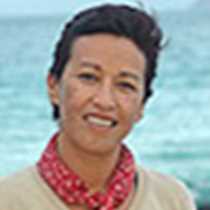Gardner Bay and Punta Suarez on Española Island
We had a late wake up call, which felt great after all the early mornings. Lynn, the Expedition Leader has been getting us up early, but we can’t complain because we have had a wonderful time here on the M. S. Islander. This morning the sun was shining and soon after breakfast we were ready to depart for our snorkeling activity at Turtle Island. The water temperature was a marvelous 75 º F. We were welcomed by hundreds of tropical fish including a white-tipped reef shark resting under a rocky ledge. After awhile with smiles on our faces showing the satisfaction we all felt, we headed to the coralline beach of Gardner Bay. This beach was formed many years ago by the disintegration of white coral after passing through the digestive tracks of parrot fish, and is some of the finest sand in the world (Parrot fish poop??? Oh, how disguising!!!).
The afternoon’s excursion began at 3:30 p.m. with a dry landing at Punta Suarez. “Christmas” marine iguanas (this species is green and red) were basking on the rocks, soaking up the heat to regulate their body temperatures. Hood mockingbirds curiously looked over our backpacks trying to find fresh water, which is very scarce on the island. During our walk to the cliffs, which serve as a runway for the albatross, we were delighted to witness their famous mating ritual. We watched their clumsy and dangerous landings among the lava boulders, as well as their easy take offs from the edges of the cliff. Here on Española there are twelve thousand pairs of breeding albatrosses. This year only a very few of them along the trail have successfully hatched a chick. This afternoon we only found one little fluffy chick of about three weeks old, that we hope will survive.
He will be fed nutrient-rich oil by his parents, which has been processed from fish in their proventriculous, an elongation of the stomach. In this organ albatross can store as much as two litters of the heavy oil with which they feed their chicks. He will be able to take off at the end of December, once he reaches adult size, and spend the next few years feeding at sea.
Continuing our walk along the cliffs of Española, we found Nazca boobies and blue footed boobies incubating their eggs and guarding their chicks. The blowhole, where water was blown through a fissure and shot more than one hundred feet into the air, was spectacular. As the day ended and we were done with our final excursion ashore, we returned to the Islander with happy faces, and in many of our hearts we felt that this had been the trip of a lifetime!
We had a late wake up call, which felt great after all the early mornings. Lynn, the Expedition Leader has been getting us up early, but we can’t complain because we have had a wonderful time here on the M. S. Islander. This morning the sun was shining and soon after breakfast we were ready to depart for our snorkeling activity at Turtle Island. The water temperature was a marvelous 75 º F. We were welcomed by hundreds of tropical fish including a white-tipped reef shark resting under a rocky ledge. After awhile with smiles on our faces showing the satisfaction we all felt, we headed to the coralline beach of Gardner Bay. This beach was formed many years ago by the disintegration of white coral after passing through the digestive tracks of parrot fish, and is some of the finest sand in the world (Parrot fish poop??? Oh, how disguising!!!).
The afternoon’s excursion began at 3:30 p.m. with a dry landing at Punta Suarez. “Christmas” marine iguanas (this species is green and red) were basking on the rocks, soaking up the heat to regulate their body temperatures. Hood mockingbirds curiously looked over our backpacks trying to find fresh water, which is very scarce on the island. During our walk to the cliffs, which serve as a runway for the albatross, we were delighted to witness their famous mating ritual. We watched their clumsy and dangerous landings among the lava boulders, as well as their easy take offs from the edges of the cliff. Here on Española there are twelve thousand pairs of breeding albatrosses. This year only a very few of them along the trail have successfully hatched a chick. This afternoon we only found one little fluffy chick of about three weeks old, that we hope will survive.
He will be fed nutrient-rich oil by his parents, which has been processed from fish in their proventriculous, an elongation of the stomach. In this organ albatross can store as much as two litters of the heavy oil with which they feed their chicks. He will be able to take off at the end of December, once he reaches adult size, and spend the next few years feeding at sea.
Continuing our walk along the cliffs of Española, we found Nazca boobies and blue footed boobies incubating their eggs and guarding their chicks. The blowhole, where water was blown through a fissure and shot more than one hundred feet into the air, was spectacular. As the day ended and we were done with our final excursion ashore, we returned to the Islander with happy faces, and in many of our hearts we felt that this had been the trip of a lifetime!




